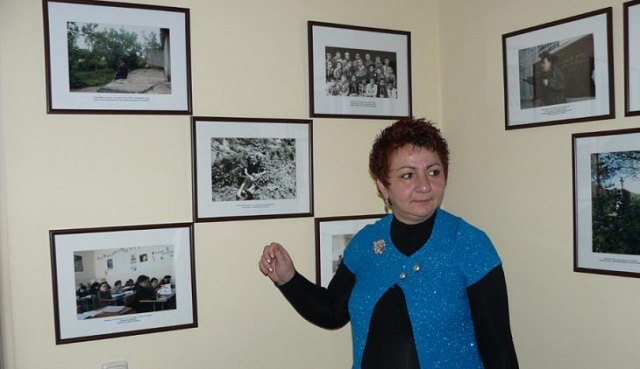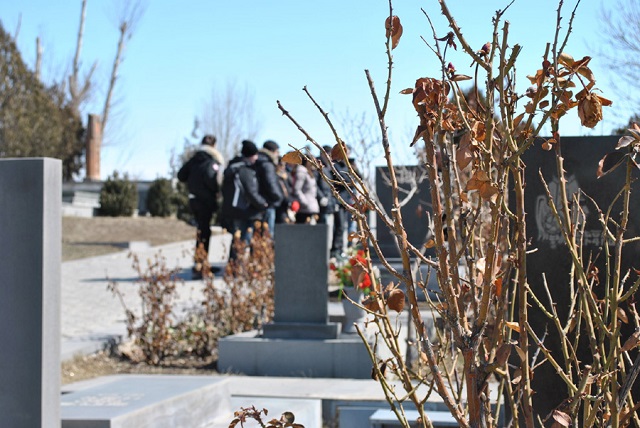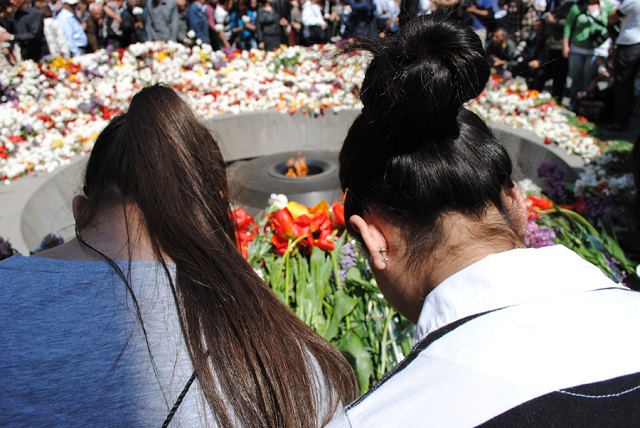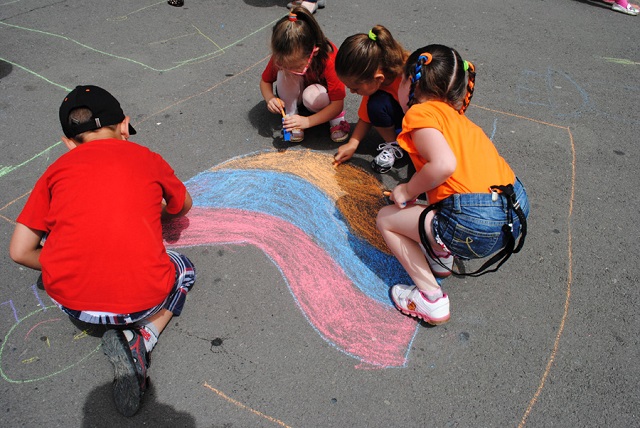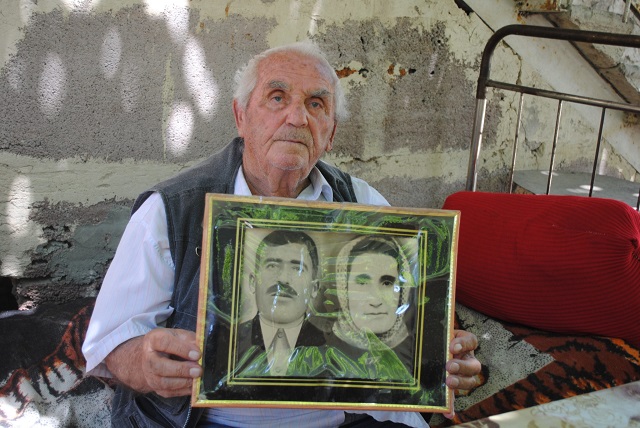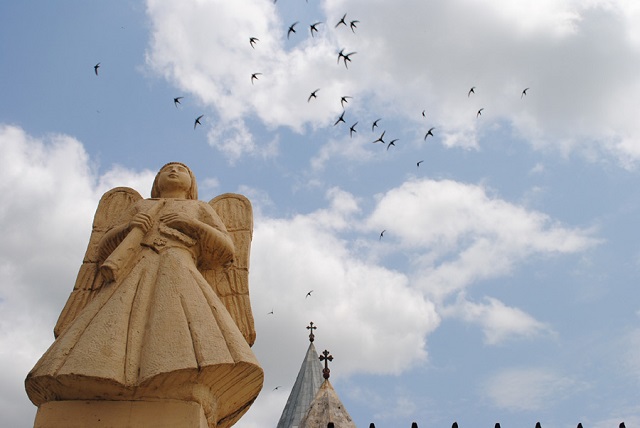Horizon. The Greek Armenian Dr. Mkhitaryan, born and raised in Yerevan, Armenia to an Armenian father and a Pontic Greek mother (Nina Lazareva (Lazaridou), born in the village of Madan, in northern Armenia in 1931), has devoted three years to extensive historical and photographic research on the Greek community in Armenia.
She received her PhD in Mathematical Physics in 1993 from Yerevan Physics Institute. In 1994-95 she conducted research at the University of Ghent, in Belgium on archeology. In 1995-97, she did post-doctoral studies at Aristotle University of Thessaloniki, Greece, on archeology. She started amateur photography in 2007, and has had 4 prior exhibitions. Her first exhibition was held in 2009, dedicated to Greeks of Armenia, in loving memory of her Greek mother, at the Greek Embassy in Armenia. Her second exhibition was again dedicated to Greeks of Armenia and held at the Greek Consulate of New York, USA in 2011. The third exhibition ’’My Heart is in the Highlands’’ was dedicated to Armenia and Karabakh, and was held in Shushi, Artsakh in 2013. The fourth exhibition ”Inspired by Armenia” opened in Yeghiche Charents House-Museum, Yerevan. In April, 2015 her photo exhibit dedicated to the Armenian Genocide Centennial. was opened in Yerevan.
By Nazeeg Haneshian
Read also
How have you come to documentary photography? What was a primary impulse?
In 2007 I gave a public talk on the Greek Community of Armenia at AUA. For the mentioned lecture I visited all the Greek settlements of the country and took a few thousand photographs. This was a beginning.
All my documentary photography projects were performed as a complete research thank the strong scientific background. In 2009 the first photographic exhibit was opened at the Greek Embassy in Yerevan in loving memory of my Greek mother and in celebration of all mothers. I am happy to state that the exhibit is in a permanent view at the Greek Embassy. My Greek mother’s image is a unit of this cultural display.
How are the Armenian and Greek historical topics interconnected in your creative documentary photography projects?
In 2013 I opened the photographic exhibit in Shushi, Artsakh ‘’My heart in the highlands’’. My love to Artsakh was reflected in the displayed photographs. Keeping in mind that there is a Greek village in Artsakh – Mekhmana, I visited it and a few shots were included in my exhibition. I was feeling blessed and honoured to open this exhibit in such a beautiful city.
I made my own contribution in the process of paying a tribute to our ancestors whilst marking the Armenian Genocide centennial in 2015. One of my documentary photography projects is dedicated to the three genocides: Armenian, Greek, and Assyrian. The portraits of the survivors, their descendants, the narratives, families’ archival stories are available on my website.
Tell us about some of the cities that have taken your exhibits.
In 2011 upon the invitation of Dr. Virginia Davies and AGAPW (Association of Greek Professional Women, Founder and President Dr. Olga Alexakos) my second photographic exhibition dedicated to the Hellenes of Armenia was opened at the Greek Consulate General in New York, USA. The photographs were ‘’speaking’’ inspired by the Pontian lyra melody. All this created a heart-warming atmosphere.
https://www.greeknewsonline.com/the-greek-armenian-connection-at-the-greek-consulate-bringing-cultures/
I remember the exceptional welcoming at the Hellenic Cultural Center in London in 2017 when my presentation started with the song performed by Stelios Kazantzidis ’’Mana mou’’. These projects inspire and support me to meet new challenges in my life. Through these photographs my Greek mother’s prayers and blessings are always in my heart. As it was fairly noted by Abraham Lincoln: “I remember my mother’s prayers and they have always followed me. They have clung to me all my life.”
My project dedicated to the three genocides was titled ’’We live, we remember, we pray’’. The aim was to understand whether can memory trigger a genocide prevention to some extent. The exhibit was opened on the 26th of April 2015, just after two days of the main commemoration event at the Tsitsernakaberd Genocide Memorial in Yerevan. The venue was the house-museum of the famous Armenian poet Yeghishe Charents. However I would like to mention about one exhibition dearest to my heart.
One day in May 2015 I took about thirty photographs and headed to the mountainous village Hak which is located in the Berdzor region of Artsakh (Nagorno-Karabakh). In one of the village school room I was showing the images to the inhabitants who know very well what it means to be refugee, fight for the country independence etc.
I gifted the genocide related photo collection to the orphanage in Yerevan, in blessed memory of my Armenian grandfather who was one of the 1915 orphans.
I could not imagine that pain of home loss is so sharp even in one century. The narratives of survival and exile of the survivors and their descendants were ’’knitted’’ from pain. The overwhelming US House passage of the Armenian Genocide Resolution (#296) on the 29th of October 2019 is a historic moment, turning point in the entire process of the Armenian genocide recognition. However we have to consider matters within the international context. This is a victory of humanity: we want to see our globe without genocide, with blue and peaceful sky. Hopefully one day the Armenian, Greek, Assyrian genocides will be recognized worldwide.
What is home for you?
Perhaps this is the most difficult question for me, a question without response. Home is not only a place, country for me, it is a concept. As a person of Armenian-Greek origin, as a person holding the dual citizenship (Armenian-Greek), I do not want to consider any geographical border for my home. As I am kidding, in spirit I am Gypsy, in heart – Greek, in prayers – Armenian and in mind – a citizen of the world. The last three years I was working in the Netherlands and Cyprus. I had a chance to visit the Turkish occupied part of Cyprus. While praying during the liturgy in the Armenian Church on Victoria Street in the Turkish occupied part of Nicosia in 2018, I felt the concept of HOME. If we have an opportunity to pray in our churches, this is a fold of the home concept. We can state this undoubtedly as the descendants of the Christian minority persecuted in the Ottoman Empire in 1915. The mentioned concept is an impulse for me to visit zones of conflict and reflect such topics in my documentary photography projects.
What does you own future hold?
Good question. Being a member of the binational family enabled me to learn four languages, think out-of-the-box, consider and analyse things in the international context beyond any national borders. I am always inclined to understand the core of a scientific problem, review roots and observe a situation from the outside. I have always had the curiosity, passion and interest in the fascinating challenges of solving scientific problems. For this reason I chose the field of theoretical physics as an opportunity to understand and explore the universe and its laws. After completing my Ph.D. on the crossroad of mathematics and mathematical modelling, my mind was attracted to archaeology, another field where I studied the evidence of our civilization, history and evolution.
I worked for almost 15 years in the Christian organization, Mother See of Holy Etchmiadzin, the religious and spiritual center of all Armenians scattered across the globe. The work in that religious organization taught me to be empathetic to others offering assistance to those in need. This feature highlights a vision of my future.
I have started a global photographic project PEACE AND PHOTOGRAPHY which will include photographs from the zones of conflict as well. A part of it is available on my third website. A special attention will be focused on women in zones of conflict.
I am based now again in Armenia. The lockdown connected with the coronavirus crisis blocked my creative projects temporarily. Hopefully soon I will be able to continue to work on them.



















































